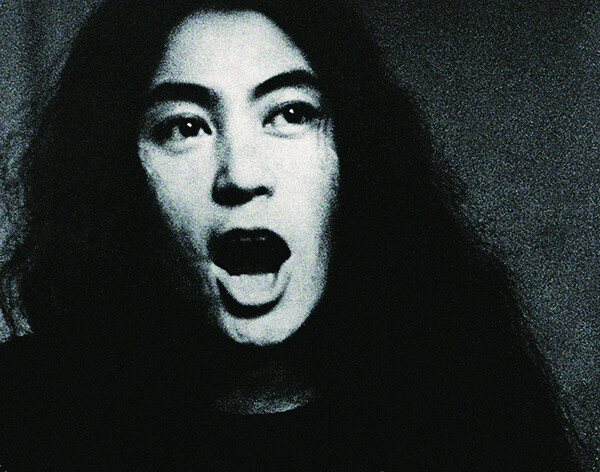Dream Come True
June 24–October 31, 2016
Avda. Figueroa Alcorta 3415
Buenos Aires
Argentina
Hours: Wednesday–Monday 12–8pm
prensa@malba.org.ar
MALBA presents Yoko Ono. Dream Come True, the first retrospective of Yoko Ono (Tokyo, 1933) ever held in Argentina. Ono is an essential and pioneering figure in conceptual and participatory contemporary art. The show curated by Gunnar B. Kvaran and Agustín Pérez Rubio includes over 80 works, among them texts, objects, videos, films, installations, and sound recordings produced from the early 1950s to the present. The cornerstone of the show are the “Instruction Pieces,” which Ono has been working on for over 60 years. The title of the show can be read as a metaphor for Ono’s artistic career, but also as a commentary on the current global situation which, in Ono’s view, can be improved by group participation and creative exchange.
Ono is associated with conceptual and performance art, as well as the neo-avant-garde Fluxus movement and the happenings of the 1960s. She was one of the first to question the concept of the work of art and the artwork as object, breaking traditional boundaries between artistic disciplines. By inviting viewers to play an active role in the production of the work, she has created a new modality in the relationship between artist and viewer. Ono uses a clear and universal language to produce objects, events, rituals, and actions that culminate in the precise terms she formulates with audience participation. The “Instruction Pieces” consist of simple and poetic messages that invite viewers to perform specific actions such as “listen to the sound of the earth turning” or “light a match and watch till it goes out.”
The exhibition project encompasses two instances: the exhibition proper in MALBA’s galleries and the exhibition and communication of a great many works in the public space, the mass media, the internet, and social media. Instructions can be read, then, not only on the walls of MALBA’s galleries, but also on the pages of a newspaper, as part of a “dance festival,” on a billboard in the middle of a major avenue, at a bus stop or subway station; or they are heard on loudspeakers or the radio, or whispered in one’s ear; they might be received in an e-mail or as an image that goes viral on facebook.
In the framework of Dream Come True, Yoko Ono has invited Latin American women who have been subjected to gender violence to form part of the Arising / Resurgiendo project. The work compiles the testimonies received—a text that describes the experience and a photograph of the eyes of the participant—in an installation in MALBA and on the exhibition’s website. Through this instruction, addressed solely to women, Ono offers catharsis and healing to those women whose bodies and minds have been afflicted by acts of aggression. Also, for the exhibition, Ono invited a group of 12 Latin American artists—six men and six women—to produce a work-vessel capable of “taking water” to people, whether to heal their minds or to recognize their courage in expressing themselves. The artists invited for the Water Event were Alexander Apóstol, Tania Bruguera, Antonio Caro, Ana Gallardo, Alfredo Jaar, Runo Lagomarsino, Teresa Margolles, Hernán Marina, Amalia Pica, Liliana Porter, Rosângela Rennó and Tercerunquinto. The work could be addressed to a person, people, or region that desperately needs water. Yoko Ono completes the work of the participating artists by symbolically providing water to fill those vessels. Each of the works will be exhibited in the museum’s galleries as part of the show.
MALBA will publish two books: The exhibition catalogue published solely in Spanish at the explicit request of the artist and and a re-edition of 1,000 copies of Ono’s Grapefruit (1964). In 1970, the first Spanish-language edition of Grapefruit (“Pomelo” in Spanish) was published in Buenos Aires by Ediciones de la Flor publishing house. The edition was so popular it is still sold out.
In Dream Come True, Yoko Ono expands the breadth of a body of work with a strong political and social commitment, specifically to the feminist, pacifist, and environmentalist movements. Ono invites us to embark on an experience that will transform our relationship to ourselves and to others.
Also on view at MALBA:
Voluspa Jarpa. En nuestra pequeña región de por acá (In our little region over here)
July 15–October 3, 2016
Curated by Agustín Pérez Rubio, this site-specific project at MALBA is the first individual exhibition of work by Voluspa Jarpa (Rancagua, Chile, 1971) ever held in a Latin American museum. Recent group shows featuring her work include the VI Havana Biennial, Cuba; the III Bienal do Mercosul, Brazil; the 11th Shanghai Biennial, China; the 12th Istanbul Biennial, Turkey; and the 31st São Paulo Biennial, Brazil. The project at MALBA focuses in the investigation of declassified documents of the Intelligence Services of USA dated between 1948 up to 1994 and related to a group of Latin-American leaders of the Cold War period that had high-level positions and were assassinated or victims of unresolved crimes. The exhibition also questions North American Minimalism, opposing that movement’s austerity and formal asceticism with the political violence that took place at its height.


